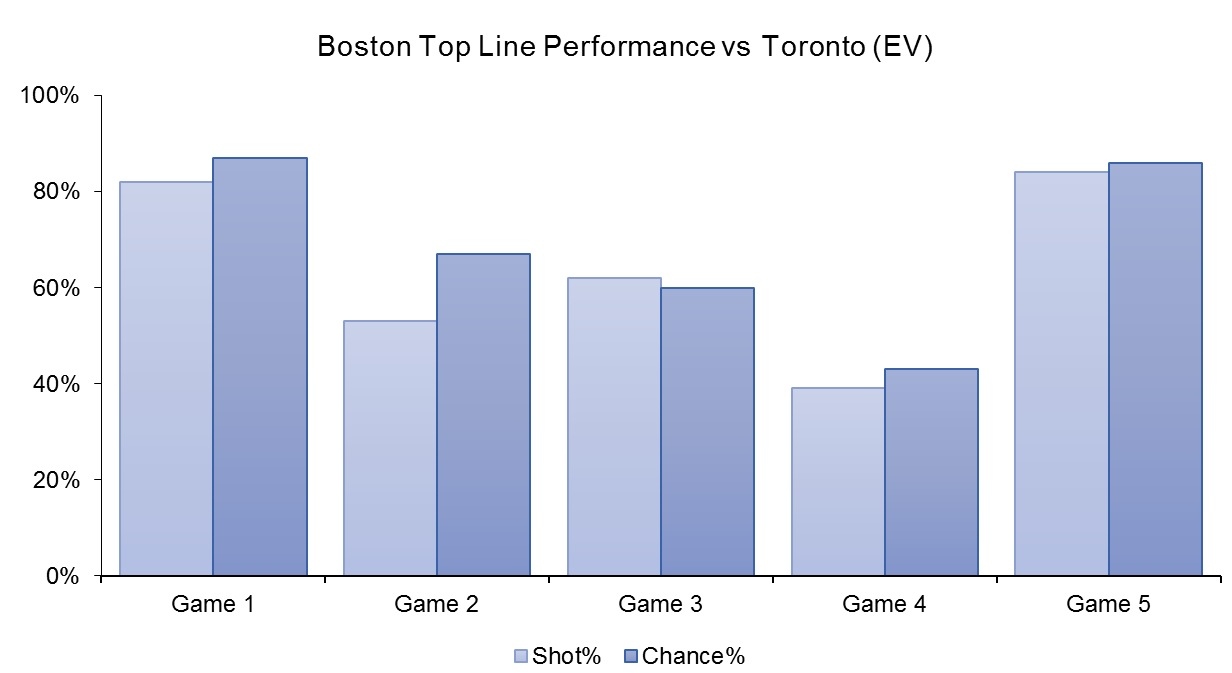Apr 23, 2018
Bergeron line a nightmare for Maple Leafs
Boston’s top line of Patrice Bergeron, David Pastrnak and Brad Marchand has put on a dominating display against Toronto so far in the first-round series, Travis Yost writes.
By Travis Yost

The Toronto Maple Leafs are two wins away from advancing to the second round of the Stanley Cup playoffs. They’ll need to figure out a way to slow down Boston’s top line if they hope to get there.
One of the interesting stories of this series was always going to concern Toronto’s strategy against the Patrice Bergeron line. The Bergeron line has pumped opponents all season long and no one expected it to be any different in the opening round.
Toronto, for all of their strengths, is not a team that can assemble an elite checking line to slow down opponents. When they are humming, it’s usually because they are putting so much pressure on teams in the offensive third. When they don’t have their puck-possession game, things get dicey very quickly.
That was on full display in Game 5. Toronto moved out to an early lead and parlayed big goals by Connor Brown, Andreas Johnsson, Tyler Bozak, and James van Riemsdyk into victory. But they sure made things interesting. After their fourth goal, Toronto throttled back and Boston pushed forward. What ensued was more or less a 30-minute siege of Toronto goaltender Frederik Andersen.
One of the reasons the Bruins nearly completed the comeback was because the Boston top line spent every single shift applying offensive zone pressure. Some of this was score effects. Some of this was not.
The Bruins ended up outshooting the Leafs 70 to 37 (65 per cent) and outchancing them 39 to 18 (69 per cent) at even strength in Game 5. The numbers the Bergeron line put up were dominating, and a continuation of what we’ve seen all series long.
Below I’ve graphed out the shots and scoring chances on a game-by-game basis since the series began. The numbers show what Boston’s top line has done against Toronto during the series. That line sees David Pastrnak and Brad Marchand on the wing almost exclusively; though note that Bergeron – who missed Game 4 due to injury – was backfilled by Riley Nash. (via NST)

Anything above 50 per cent is a matchup that Toronto is losing. Anything past 60 per cent is usually indicative of a bloodbath. Absent Game 4 – the game Bergeron was unavailable to Boston – the Bruins have just completely owned this matchup. Game 5 was one of the most one-sided single game efforts observed during the modern playoff era. The Bergeron line outshot Toronto 31 to six (84 per cent) and outchanced them 18 to three (86 per cent). It’s the biggest reason why Toronto nearly lost control of a game that should have been a comfortable victory. (As an aside, the Bergeron line has outscored Toronto eight to four in the series, so goals are just as indicative of performance here.)
One of the things I have grown increasingly curious about is how Toronto coach Mike Babcock is trying to deal with Boston’s top unit. There are two schools of thought here – the first is that you deploy your best offensive players and try to force Boston to play in their zone as much as possible. The second is that you deploy your best defensive players and hope to keep Boston out of the goal column.
Toronto has tried a little bit of both. In the opening two games, when Boston had last change, the Bruins hunted the head-to-head matchup with Auston Matthews, which also meant more servings of the Jake Gardiner pairing. When home ice flipped to Toronto, we saw what Babcock preferred. That was harder matching of his “checking line” and Tomas Plekanec’s group, and more of his defensive pairing in Morgan Rielly and Ron Hainsey.
When Game 5 rolled around, that matchup stuck – in large part because Toronto was playing their defensive-minded players so aggressively due to the lead. It hasn't helped that they’ve had to shuffle things around a bit with Nazem Kadri sidelined for three games due to suspension.
Here’s what common opponents look like on a game-by-game basis:

The interesting takeaway to me is that it really hasn’t mattered who has played against that line because nothing worked. Maybe that’s part of Babcock’s end-game here. Maybe his only goal is to get out as unscathed as reasonably possible in that matchup and try to win the rest of the battles further down the lineup. That’s similar to Ottawa’s successful playbook last year, though Toronto just doesn’t have a defenceman who can play 30 minutes a night.
I fully expect Babcock to go back to the well in Game 6, pushing his checking line out against Bergeron as much as humanly possible. If they can somehow avoid those sustained offensive zone shifts and continue to free up easier minutes for Toronto’s skill players, it could very well force a Game 7 back in Boston.
It may be the best approach for what Toronto has at their disposal right now. But you have every right to be skeptical about the effectiveness of the plan. Bergeron and his wingers have been a nightmare for the Leafs, and will likely remain so over the next two games.


